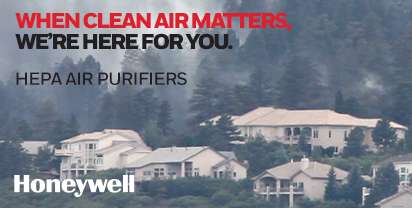A wildfire can have tragic and widespread effects, and one of the farthest-reaching dangers is the smoke it produces.
Wildfire smoke is a complex mixture of substances that can negatively impact health. The issue is compounded by the fact that wildfire smoke can travel for thousands of miles, polluting the air nearby and far from the fire itself.
Take a look at some of the things you could breathe in during a wildfire, and learn why it’s important to limit your exposure to wildfire smoke.
What’s in wildfire smoke?
Wildfires often burn more than trees – buildings and man-made materials can also be burned. The result is not only increased devastation, but smoke that contains a wide variety of pollutants, including:
- Fine particulate matter.
Burning breaks down material into tiny particles that can get into your eyes, nose and throat, causing irritation. The tiniest particles are called “fine particulate matter” – they have a maximum diameter of 2.5 micrometers (20 times smaller than the width of a human hair). Fine particulate matter is dangerous because it can get deep into lungs and potentially cause or worsen problems with breathing and overall health.
According to the EPA, fine particles make up approximately 90% of the total particle mass emitted from wildfires.
- Byproducts of burning wood and vegetation.
Many people think that wood smoke smells good, but it actually contains harmful substances. Smoke from wood and organic matter can contain known carcinogens such as benzene and formaldehyde. - Byproducts of burning building materials.
Treated lumber, plastics, metals and a wide range of building materials may burn in a wildfire. The gasses and particles that are released can include an enormous range of irritants and volatile organic compounds (VOCs), which can harm health. - Ozone
Ozone gas is not released by wildfires, but it can be produced in the air as wildfire smoke moves downwind, especially in urban and industrial areas. Ozone can irritate the throat and lungs, exacerbating conditions such as asthma.
What can you do to protect yourself from wildfire smoke?
While wildfire smoke is a definite menace, there are many things you can do to limit your exposure to it when wildfires are occurring:
- Protect your indoor air.
Keep your windows and exterior doors closed, and use air purifiers with HEPA filters to reduce smoke particles in your air. - Limit outdoor activity.
Don’t exercise outside or let your children play outside. If you live close to a wildfire and need to be outdoors, talk to your doctor about using an N-95 or P-100 mask. - Know your air quality.
Sites like airnow.gov and airquality.weather.gov provide fast information on the air quality in your area, including levels of fine particulates, ozone, and larger pollutants like dust.
By educating yourself about wildfire smoke and the air quality where you live, you can take steps to protect yourself and your family from potential health impacts.
Get help with protecting your indoor air quality: learn more about Air Purifiers.














